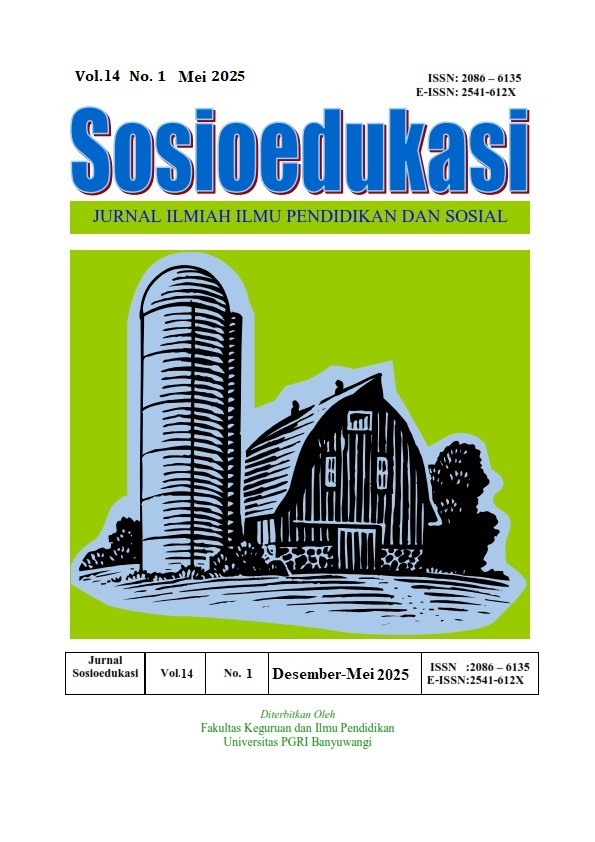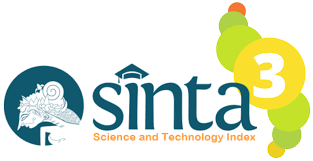IMPLEMENTATION OF TRIPLE BOTTOM LINE PRINCIPLES IN INFRASTRUCTURE PROJECTS IN NORTH SULAWESI
DOI:
https://doi.org/10.36526/sosioedukasi.v14i1.5355Keywords:
Triple Bottom Line, Sustainable Infrastructure, Development in North SulawesiAbstract
his study investigates integrating Triple Bottom Line (TBL) principles—social, economic, and environmental—into infrastructure planning and evaluation in North Sulawesi through a sequential mixed-methods design. First, a Cost–Benefit Analysis (CBA) estimated Net Present Value (IDR 45.2–85.4 billion), Benefit–Cost Ratio (1.1–1.8), and Internal Rate of Return (9.5 % over 30 years), confirming economic viability. Simultaneously, a Life Cycle Assessment (LCA) quantified material-related energy use and CO₂e emissions, while structured surveys and focus-group discussions captured community perceptions of benefit distribution and participation. These quantitative and qualitative insights were synthesized in a Multi-Criteria Decision Analysis (MCDA) employing the Analytic Hierarchy Process (AHP), where twelve experts assigned weights of 0.441 (social), 0.301 (environmental), and 0.258 (economic). Among three strategic alternatives, a low-emission public-private partnership scored highest (0.83) by combining robust stakeholder engagement, recycled-steel use with offset mechanisms, and strong long-term returns; sensitivity analysis (±10 % environmental weight) confirmed its ranking stability. By mapping outcomes to SDG 9 (Industry, Innovation and Infrastructure), SDG 11 (Sustainable Cities and Communities), SDG 12 (Responsible Consumption and Production), and SDG 13 (Climate Action), the study demonstrates that a TBL-based framework can simultaneously secure financial performance, advance social equity, and reduce environmental impact. Recommendations include formalizing hybrid financing, enhancing participatory platforms, and incentivizing low-carbon materials.
References
Alomoto, W., Niñerola, A., & Pié, L. (2022). Social Impact Assessment: A Systematic Review of Literature. Social Indicators Research, 161(1), 225–250. https://doi.org/10.1007/s11205-021-02809-1
Arora, N. K., & Mishra, I. (2023). Sustainable development goal 13: recent progress and challenges to climate action. Environmental Sustainability, 6(3), 297–301. https://doi.org/10.1007/s42398-023-00287-4
Awino, F. B., & Apitz, S. E. (2025). Solid waste management in the context of the waste hierarchy and circular economy frameworks : An international critical review. 20(1), 9–35. https://doi.org/10.1002/ieam.4774
Balkishan, N., Author, S., & Author, D. M. (2018). A Review Study on Power System Blackouts. 8(5), 432–434. https://doi.org/10.29322/IJSRP.8.5.2018.p7756
Boardman, A. E., Greenberg, D. H., Vining, A. R., & Weimer, D. L. (2018). Cost-Benefit Analysis: Concepts and Practice. Cambridge University Press. https://books.google.co.id/books?id=xj8LEAAAQBAJ
Bowen, P., Rose, R., & Pilkington., A. (2017). MIXED METHODS- THEORY AND PRACTICE. SEQUENTIAL, EXPLANATORY APPROACH. 5(2), 10–27.
Brita, A., Gawei, P., Sintani, L., Studi, P., Teknik, J., Teknik, F., & Raya, U. P. (2022). ANALISIS KONSUMSI ENERGI DAN EMISI GAS RUMAH KACA LENTUR DAN PERKERASAN KAKU. 10(2), 165–176.
Burlig, F., & Preonas, L. (2024). Out of the Darkness and into the Light? Development Effects of Rural Electrification. Journal of Political Economy, 132(9), 2937–2971. https://doi.org/10.1086/730204
Chirit, N. (2025). Triple Bottom Line in Sustainable Development : A Comprehensive Bibliometric Analysis.
Colapinto, C., Jayaraman, R., Ben Abdelaziz, F., & La Torre, D. (2020). Environmental sustainability and multifaceted development: multi-criteria decision models with applications. Annals of Operations Research, 293(2), 405–432. https://doi.org/10.1007/s10479-019-03403-y
Ekins, P., & Zenghelis, D. (2021). The costs and benefits of environmental sustainability. Sustainability Science, 16(3), 949–965. https://doi.org/10.1007/s11625-021-00910-5
Elkington, J. (1997). The triple bottom line. Environmental Management: Readings and Cases, 2, 49–66.
Elshaarawy, R., & Ezzat, R. A. (2023). Global value chains, financial constraints, and innovation. Small Business Economics, 61(1), 223–257. https://doi.org/10.1007/s11187-022-00685-8
Flyvbjerg, B., & Bester, D. W. (2021). The Cost-Benefit Fallacy: Why Cost-Benefit Analysis Is Broken and How to Fix It. Journal of Benefit-Cost Analysis, 12(3), 395–419. https://doi.org/10.1017/bca.2021.9
Gbadegesin, J. T., Ojekalu, S., Komolafe, M. O., & Oyewole, M. O. (2022). Underlying factors for effective collective decision on community-driven infrastructure in developing countries. International Journal of Construction Management, 22(11), 2121–2133. https://doi.org/10.1080/15623599.2020.1768325
Grigg, N. S. (2024). Water Distribution Systems : Integrated Approaches for Effective Utility Management.
Guerrero, O. A., & Castañeda, G. (2022). How does government expenditure impact sustainable development ? Studying the multidimensional link between budgets and development gaps. Sustainability Science, 17(3), 987–1007. https://doi.org/10.1007/s11625-022-01095-1
Hales, R., & Birdthistle, N. (2023). The Sustainable Development Goals – SDG # 12 Responsible Consumption and Production. 1–10. https://doi.org/10.1108/978-1-80455-840-920231001
Han, X., Su, J., & Thia, J. P. (2021). Impact of infrastructure investment on developed and developing economies. Economic Change and Restructuring, 54(4), 995–1024. https://doi.org/10.1007/s10644-020-09287-4
Islam, M. M. M. (2025). Assessing health risks and disease burden from waterborne pathogens across multiple urban exposure pathways. 15(4), 322–332. https://doi.org/10.2166/washdev.2025.306
Jiang, W., & Marggraf, R. (2021). The origin of cost–benefit analysis: a comparative view of France and the United States. Cost Effectiveness and Resource Allocation, 19(1), 74. https://doi.org/10.1186/s12962-021-00330-3
Joshua, J. (2019). The Development of Infrastructure and Economic Growth. In The Belt and Road Initiative and the Global Economy: Volume I -- Trade and Economic Development (pp. 105–134). Springer International Publishing. https://doi.org/10.1007/978-3-030-28030-7_5
Kadigi, W. R., Ngaga, Y. M., & Kadigi, R. M. J. (2021). Economic Viability of Smallholder Agroforestry and Beekeeping Projects in Uluguru Mountains , Tanzania : A Cost Benefit Analysis. 83–107. https://doi.org/10.4236/ojf.2021.112007
Karibul, H. M., & Gentil, B. (2024). Comparative Study of Cradle-to-Gate Carbon Emissions from Steel and Concrete Structures of Bangladeshi Industrial Projects. December. https://doi.org/10.46610/JoRAIS.2024.v09i03.005
Khairin, F. N., Bone, H., Syakura, M. A., Yudaruddin, R., Khairin, F. N., Bone, H., & Syakura, M. A. (2022). Structure of local government budgets and local fiscal autonomy : Evidence from Indonesia. https://doi.org/10.21511/pmf.11(1).2022.07
Khan, A. M. (2024). The Geopolitics of Global Infrastructure Projects : Challenges and Opportunities for Health and Wellbeing.
Küfeoğlu, S. (2022). Emerging Technologies Value Creation for Sustainable Development.
Law, L., & Jeffrey, J. C. G. (2014). Capacities in Facing Natural Hazards : A Small Island Perspective. 247–264. https://doi.org/10.1007/s13753-014-0031-4
Liao, J. (2024). The Relationship between Green Infrastructure and Air Pollution , History , Development , and Evolution : A Bibliometric Review.
Lumi, Y. R., & Budiarto, R. (2022). Analysis of Electrical Energy Needs and Supply Strategies in North Sulawesi Province. 8(2). https://doi.org/10.29303/jppipa.v8i2.1441
Madadizadeh, A., Siddiqui, K., & Aliabadi, A. A. (2024). Review : The Economics Landscape for Building Decarbonization. 1–28.
Mahmoud, K., Aziz, A., Osama, A., & Kumar, A. (2025). Integrating digital mapping technologies in urban development : Advancing sustainable and resilient infrastructure for SDG 9 achievement – a systematic review. Alexandria Engineering Journal, 116(December 2024), 512–524. https://doi.org/10.1016/j.aej.2024.12.078
Mehraban, R. A., Tsantilis, L., & Riviera, P. P. (2025). Comprehensive Analysis of Sustainability Rating Systems for Road Infrastructure. 1–25.
Minetti, R., Rotondi, Z., Murro, P., & Zhu, S. C. (2019). FINANCIAL CONSTRAINTS, FIRMS’ SUPPLY CHAINS, AND INTERNATIONALIZATION. Journal of the European Economic Association, 17(2), 327--375. https://www.jstor.org/stable/26642109
Moutik, B., Summerscales, J., Graham-jones, J., & Pemberton, R. (2023). Life Cycle Assessment Research Trends and Implications : A Bibliometric Analysis.
Nabiyeva, G. N., Wheeler, S. M., & London, J. K. (2023). Implementation of Sustainable Development Goal 11 ( Sustainable Cities and Communities ): Initial Good Practices Data. 11.
Nigumann, E., Kalamees, T., Kuusk, K., & Pihelo, P. (2024). Circular renovation of an apartment building with prefabricated additional insulation elements to nearly zero energy building. Journal of Sustainable Architecture and Civil Engineering, 34(1), 22–34.
Nwokike, L. I. (2021). INTERNATIONAL WATERWAYS AND DUMPING OF WASTE IN THE SEAS/OCEAN: EFFECTS, RESPONSIBILITIES AND CHALLENGES UNDER INTERNATIONAL LAW. 9(1), 12–23.
Okay, N. C., Sencer, A., & Taskin, N. (2024a). Quantitative indicators for environmental and social sustainability performance assessment of the supply chain.
Okay, N. C., Sencer, A., & Taskin, N. (2024b). Quantitative indicators for environmental and social sustainability performance assessment of the supply chain. Environment, Development and Sustainability. https://doi.org/10.1007/s10668-024-05210-3
Palinkas, L. A., Springgate, B., Cabassa, L. J., Shin, M., Garcia, S., Crabtree, B. F., & Tsui, J. (2025). Methods for community-engaged data collection and analysis in implementation research. Implementation Science Communications, 6(1), 38. https://doi.org/10.1186/s43058-025-00722-z
Perricone, V., Mele, A., Buono, M., & Vicinanza, D. (2023). Nature-based and bioinspired solutions for coastal protection : an overview among key ecosystems and a promising pathway for new functional and sustainable designs. April, 1218–1239. https://doi.org/10.1093/icesjms/fsad080
Pfe, K. (2019). Global Ambitions , Local Contexts : Alternative Ways of Knowing the World.
Purvis, B., Mao, Y., & Robinson, D. (2019). Three pillars of sustainability: in search of conceptual origins. Sustainability Science, 14(3), 681–695. https://doi.org/10.1007/s11625-018-0627-5
Rattanakunuprakarn, S., Jin, M., Sussman, M., & Felix, P. (2024). Comparative evaluation of highways and railroads using life-cycle benefit-cost analysis. International Journal of Sustainable Transportation, 18(10), 803–826. https://doi.org/10.1080/15568318.2024.2411588
Rawung, S. S., Poluakan, T. C., & Hamenda, B. (2023). The Effect Of Regional Original Revenue, General Allocation Funds, And Special Allocation Funds On Economic Growth In The North Sulawesi Province. 5(2), 73–79.
Raza, M. A., Khatri, K. L., Hussain, A., Huzaifa, M., Khan, A., Shah, A., & Taj, H. (2022). Analysis and Proposed Remedies for Power System Blackouts around the Globe †. 1–5.
Recha, J., Arndt, C., & Whitbread, A. (2024). How To Design and Implement a Climate-Smart Livestock Operation A capacity-building training for World Bank teams and project implementation units.
Reed, D. C., Schmitt, R. J., Burd, A. B., Burkepile, D. E., Kominoski, J. S., Mcglathery, K. J., Miller, R. J., Morris, J. T., & Zinnert, J. C. (2022). Responses of Coastal Ecosystems to Climate Change : Insights from Long-Term Ecological Research. 72(9), 871–888.
Scarcity, W. (2020). Water Supply and Water Scarcity. 1–16.
Scherer, L., Svenning, J., Huang, J., Seymour, C. L., Sandel, B., Mueller, N., Kummu, M., Bekunda, M., Bruelheide, H., Hochman, Z., Siebert, S., Rueda, O., & Bodegom, P. M. Van. (2020). Science of the Total Environment Global priorities of environmental issues to combat food insecurity and biodiversity loss. Science of the Total Environment, 730(April), 139096. https://doi.org/10.1016/j.scitotenv.2020.139096
Sever, S. D., & Tok, E. (2025). Sustainable Development Goals in a Transforming World : Understanding the Dynamics of Localization. 1–26.
Shayo, G. M., Elimbinzi, E., Shao, G. N., & Fabian, C. (2023). Severity of waterborne diseases in developing countries and the effectiveness of ceramic filters for improving water quality. Bulletin of the National Research Centre, 47(1), 113. https://doi.org/10.1186/s42269-023-01088-9
Shrestha, J. (2025). Rural Road Construction in Local Conditions. In Rural Road Development in Developing Countries (pp. 45–62). Springer Nature Singapore. https://doi.org/10.1007/978-981-96-2012-8_4
Siddiqua, A., Hahladakis, J. N., & Al-Attiya, W. A. K. A. (2022). An overview of the environmental pollution and health effects associated with waste landfilling and open dumping. Environmental Science and Pollution Research, 29(39), 58514–58536. https://doi.org/10.1007/s11356-022-21578-z
Singh, S., & Jayaram, R. (2022). Attainment of water and sanitation goals: a review and agenda for research. Sustainable Water Resources Management, 8(5), 146. https://doi.org/10.1007/s40899-022-00719-9
Szabo, Z. K., Sz, Z., & St, G. C. (2021). An Analytic Hierarchy Process Approach for Prioritisation of Strategic Objectives of Sustainable Development. 1–26.
Trovato, M. R., Nocera, F., & Giu, S. (2020). Life-Cycle Assessment and Monetary Measurements for the Carbon Footprint Reduction of Public Buildings.
Tseng, M.-L., Chang, C.-H., Lin, C.-W. R., Wu, K.-J., Chen, Q., Xia, L., & Xue, B. (2020). Future trends and guidance for the triple bottom line and sustainability: a data driven bibliometric analysis. Environmental Science and Pollution Research, 27(27), 33543–33567. https://doi.org/10.1007/s11356-020-09284-0
Vita, G. E. De, Visconti, C., & Ganbat, G. (2023). A Collaborative Approach for Triggering Environmental Awareness : The 3Rs for Sustainable Use of Natural Resources in Ulaanbaatar ( 3R4UB ).
Wang, Y., He, X., Zuo, J., & Rameezdeen, R. (2023). Ability or morality? Exploring the multiple dimensions of social trust on public acceptance of urban transport infrastructure projects. International Journal of Managing Projects in Business, 16(2), 301–324. https://doi.org/10.1108/IJMPB-07-2022-0152
Wang, Z., Yang, X., Fu, L., & Li, M. (2025). A review of secondary contamination of drinking water quality in distribution systems : sources , mechanisms , and prospects. 74(1), 118–141. https://doi.org/10.2166/aqua.2024.284
Yasmeen, R., Sarfraz, M., Shah, W. U. H., Ivascu, L., & Cifuentes-Faura, J. (2023). The impact of public awareness, infrastructure, and technological development with economic growth on solid waste management of European countries: does governance quality matters. Environmental Science and Pollution Research, 30(53), 113442–113456. https://doi.org/10.1007/s11356-023-30356-4
Zaharia, R. M., & Zaharia, R. (2021). Triple Bottom Line. In D. Crowther & S. Seifi (Eds.), The Palgrave Handbook of Corporate Social Responsibility (pp. 75–101). Springer International Publishing. https://doi.org/10.1007/978-3-030-42465-7_2









.png)

















